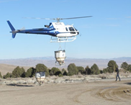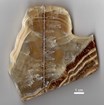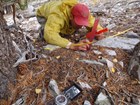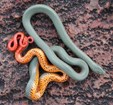The Midden is the Resource Management Newsletter of Great Basin National Park, published each summer and winter. Find out the latest going on at Great Basin National Park, Nevada in resource management and research. The Midden - Great Basin National Park: Vol. 17, No. 1, Summer 2017.
-
Great Basin National Park
Article 1: Strawberry Fire Burned Area Rehabilitation and Restoration

Wildlife, BLM, and Great Basin National Park staff. Seed was flown onto 811 acres of park lands and 1,157 acres on the BLM by Reeder Flying Service. Sourcing locally adapted seed was a priority for both the BLM and the park. Read more
-
Great Basin National Park
Article 2: Steps to BCT Recovery on Snake Creek

In August of 2016 Great Basin National Park, in collaboration with Nevada Department of Wildlife (NDOW) and staff from other NPS units, conducted a rotenone treatment on Snake Creek. The goal of the treatment was to eradicate all non-native fish in the section of Snake Creek that is located within the park boundary. Read more
-
Great Basin National Park
Article 3: Stalagmites Show Drying of the Great Basin 8,200 Years Ago

The Great Basin has experienced dramatic hydroclimate changes over the past 30,000 years and beyond. Today’s dry Great Basin is very different from the much wetter conditions that prevailed over most of the last 30,000 years. Stalagmites from caves are rich archives of past climate information. Geochemical analyses of stalagmite calcite can provide information about past conditions in and around a cave. Read more
-
Great Basin National Park
Article 4: Measuring Fuels in Bristlecone Pine Communities

Great Basin bristlecone pines (Pinus longaeva) are among the oldest organisms on earth, an icon of western forests. Bristlecone pines grow at the highest elevations in mountain ranges of the Great Basin in the western United States, and many park visitors have seen the ancient groves. Read more
-
Great Basin National Park
Article 5: Results of the 2016 Centennial Bird BioBlitz

To celebrate the 2016 Centennial of the National Park Service, Great Basin National Park held a Bird BioBlitz on May 20-22, 2016. During the 2.5 day event, over 1,500 volunteer hours were spent looking for birds. We recorded 1,843 birds representing 73 species. The most common were Mountain Chickadees, Clark’s Nutcrackers, and Pine Siskins (Figure 1). Read more
-
Great Basin National Park
Article 6: Rare Species Find Reaffirms Importance of Long-Term Research

A seemingly small but important victory for long-term ecological research was accomplished when the presence of a ringneck snake (Diadophis punctatus) was documented for the first time within a 100-mile stretch of this region. It is a vital piece of the natural history of these highly cryptic snakes that would likely have stayed missing longer if not for someone visiting the same spot in the desert every year, 10 times a year, for 18 years. Read more
-
Great Basin National Park
Article 7: 2017 Lichen BioBlitz

This year, Great Basin National Park will hold its ninth BioBlitz. Each year, the park focuses on a different topic, from beetles to birds and now to lichens. Results help the park learn more about what lives in the park and where it is found. Read more
